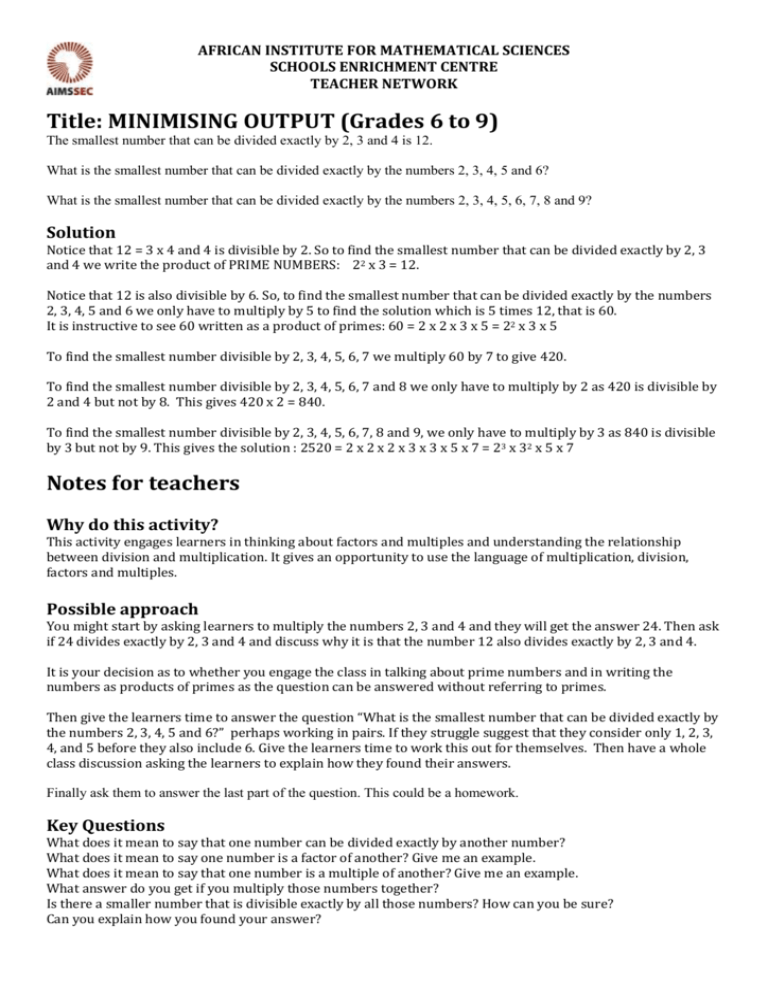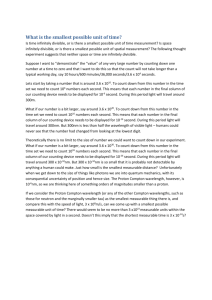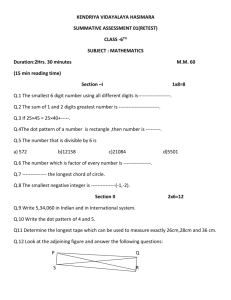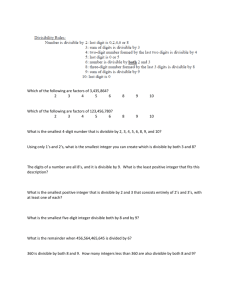AIMSSEC Teacher Notes MINIMISING OUTPUT
advertisement

AFRICAN INSTITUTE FOR MATHEMATICAL SCIENCES SCHOOLS ENRICHMENT CENTRE TEACHER NETWORK Title: MINIMISING OUTPUT (Grades 6 to 9) The smallest number that can be divided exactly by 2, 3 and 4 is 12. What is the smallest number that can be divided exactly by the numbers 2, 3, 4, 5 and 6? What is the smallest number that can be divided exactly by the numbers 2, 3, 4, 5, 6, 7, 8 and 9? Solution Notice that 12 = 3 x 4 and 4 is divisible by 2. So to find the smallest number that can be divided exactly by 2, 3 and 4 we write the product of PRIME NUMBERS: 22 x 3 = 12. Notice that 12 is also divisible by 6. So, to find the smallest number that can be divided exactly by the numbers 2, 3, 4, 5 and 6 we only have to multiply by 5 to find the solution which is 5 times 12, that is 60. It is instructive to see 60 written as a product of primes: 60 = 2 x 2 x 3 x 5 = 22 x 3 x 5 To find the smallest number divisible by 2, 3, 4, 5, 6, 7 we multiply 60 by 7 to give 420. To find the smallest number divisible by 2, 3, 4, 5, 6, 7 and 8 we only have to multiply by 2 as 420 is divisible by 2 and 4 but not by 8. This gives 420 x 2 = 840. To find the smallest number divisible by 2, 3, 4, 5, 6, 7, 8 and 9, we only have to multiply by 3 as 840 is divisible by 3 but not by 9. This gives the solution : 2520 = 2 x 2 x 2 x 3 x 3 x 5 x 7 = 23 x 32 x 5 x 7 Notes for teachers Why do this activity? This activity engages learners in thinking about factors and multiples and understanding the relationship between division and multiplication. It gives an opportunity to use the language of multiplication, division, factors and multiples. Possible approach You might start by asking learners to multiply the numbers 2, 3 and 4 and they will get the answer 24. Then ask if 24 divides exactly by 2, 3 and 4 and discuss why it is that the number 12 also divides exactly by 2, 3 and 4. It is your decision as to whether you engage the class in talking about prime numbers and in writing the numbers as products of primes as the question can be answered without referring to primes. Then give the learners time to answer the question “What is the smallest number that can be divided exactly by the numbers 2, 3, 4, 5 and 6?” perhaps working in pairs. If they struggle suggest that they consider only 1, 2, 3, 4, and 5 before they also include 6. Give the learners time to work this out for themselves. Then have a whole class discussion asking the learners to explain how they found their answers. Finally ask them to answer the last part of the question. This could be a homework. Key Questions What does it mean to say that one number can be divided exactly by another number? What does it mean to say one number is a factor of another? Give me an example. What does it mean to say that one number is a multiple of another? Give me an example. What answer do you get if you multiply those numbers together? Is there a smaller number that is divisible exactly by all those numbers? How can you be sure? Can you explain how you found your answer? Possible Extension The list of numbers in the question can be extended to include 10, then extended to include 10 and 11 and so on… Ask learners to carry on this process and to see if they can find any patterns. Possible Support You might ask ‘What is the smallest number that divides exactly by 2, 3, 4, and 5?” and give the learners time to work this out for themselves. Ask them to explain how they found their answers. Then ask ‘What is the smallest number that divides exactly by 2, 3, 4, 5 and 6?” and give the learners time to work this out for themselves. Ask “Does that change the answer?’ and “Why or why not?” Then suggest that they include 7 in the list. Does that change the answer? Then point out that the question also asked “What is the smallest number that can be divided exactly by the numbers 2, 3, 4, 5, 6, 7, 8 and 9?”. By this time learners may expect to find it is easier to get the solution in stages by including one more number in the list at each stage.








